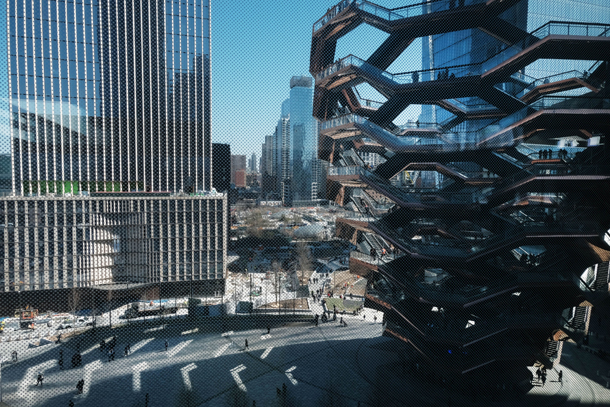Lessons from the Big Apple

The author is a columnist at the JoongAng Ilbo.
A modern urban redesign comes down to building up. Seoul Mayor Park Won-soon may think reconstructing some worn-out buildings and street shops will be enough for a face-lift, but a saturated metropolitan city like Seoul — which has no more room for horizontal expansion — must go up. It needs to raise the bar to create a new skyline with multistory architecture and innovative structures. But the mayor is prejudiced against height. He turns away residents of Gangnam District in southern Seoul, who persistently demand permits for redevelopment, and instead forces them to live in apartment buildings 20 to 30 years old. That cannot be the “future of Seoul,” he said.
So, what kind of vision of Seoul does the mayor have? The newly opened Donuimun Museum offers a clue. The city bought 40 houses in the area to turned 16 of them into a venue showing how Seoul citizens lived before. The museum recreated an old-style barber shop, black-and-white photo shop and arcade to offer a retro experience to citizens and tourists. The city claimed it was “a cultural village to uphold traces of the past.” If you ask me, tax money was spent to create a mini retro village, where visitors won’t feel like going back. Going backwards cannot be the answer to the future of Seoul.
The recreation looks particularly pitiful compared to the marvelous development project of the Hudson Yards on the west side of Manhattan. The city has been redeveloping the abandoned storage yard for Long Island Rail Road trains since 2005 by putting in a whopping $25 billion for the reconstruction. The 20-year real estate project is the largest civilian development in history. By 2025, the area would be home to 16 high-rise structures for residences, office buildings, shopping malls, cultural facilities and hotels.
The completion of its first-phase has awed New Yorkers as well as visitors. They are thrilled by a new tourist destination in the Big Apple. The centerpiece is “Vessel,” a 150-foot-tall, shiny sculptural bauble designed by Thomas Heatherwick. The structure is meant to be climbed with 2,500 individual steps and 80 floors to allow people to observe the city at different heights and angles. Its creator wanted to offer a unique architectural interactive experience with the city.
Seoul Mayor Park also envisioned a mega-project in downtown Yongsan thanks to the availability of additional space after U.S. troops moved to a base in Pyeongtaek. The project would have matched the Hudson Yard project in scale, development period and location. Yet Seoul could not pull off an unprecedented redevelopment project. Lee Hyun-seok, an urban engineering professor at Konkuk University, explained why.

People visit the main square as viewed from a new cultural space, The Shed, at Hudson Yards on April 3 in New York City. Aiming to be the world’s most flexible and inclusive cultural institution, The Shed is located where the popular High Line and Hudson Yards developments meet. [AFP/YONHAP]
Another secret to the successful Hudson Yards redevelopment is the High Line, an elevated freight rail line transformed into a public park on Manhattan’s West Side. The preservation campaign was led by Joshua David and Robert Hammond, who convinced Mayor Michael Bloomberg to create a public park on the site. The Hudson Yards project would have been impossible without the High Line transformation. While the Yard stands for new development, skyscrapers and high tech in New York, the Line represents New Yorkers’ love for the city, tradition and historical preservation. Their merger has added another unique quality to the city that never sleeps. Amanda Burden, the city’s chief planner, said a successful city should feel like “a fabulous party. People stay because they are having a great time.”
Park got the idea of turning an unused elevated walkway near Seoul Station into a greenway after a visit to the High Line in 2014. He should also have a closer look at the Hudson Yards to get an idea of what urban redevelopment can be.
JoongAng Ilbo, April 18, Page 34










with the Korea JoongAng Daily
To write comments, please log in to one of the accounts.
Standards Board Policy (0/250자)